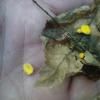
14-04-2024 10:31
Me mandan el material seco de Galicia (España) re

13-04-2024 12:11
Karen PoulsenHi I found these under loose bark on a fallen bra

13-04-2024 12:49
Karen PoulsenOn standing stem from last year. Surrounded by hyp
Phaeohelotium epiphyllum var. epiphyllum...?
Dave Wasilewski,
21-08-2015 07:30
Hans-Otto Baral,
21-08-2015 09:16

Re : Phaeohelotium epiphyllum var. epiphyllum...?
The substrate is rather unimportant. P. epiphyllum grows on any kind of woody plant parts. Likewise P. monticola which has a more intense yellow colour and which I would more expect in your case.
Dave Wasilewski,
21-08-2015 15:42
Re : Phaeohelotium epiphyllum var. epiphyllum...?
Thank you Hans-Otto. According to Index Fungorum, the current name for Phaeohelotium monticola is Hymenoscyphus monticola. This pointed me in the direction of genus Hymenoscyphus, which I see includes many species, some of which grow on old leaves.
Hans-Otto Baral,
21-08-2015 19:15

Re : Phaeohelotium epiphyllum var. epiphyllum...?
Yes, but genetic results show that P. monticola is rather distant from Hymenoscyphus and may well be separated at the genus level. See my paper on Phaeohelotium terrestre agg.
Baral H.O., Galán R., Platas G., Tena R. (2013). Phaeohelotium undulatum comb. nov. and Phaeoh. succineoguttulatum sp. nov., two segregates of the Discinella terrestris aggregate found under Eucalyptus in Spain: taxonomy, molecular biology, ecology and distribution. – Mycosystema 32: 386–428.
Baral H.O., Galán R., Platas G., Tena R. (2013). Phaeohelotium undulatum comb. nov. and Phaeoh. succineoguttulatum sp. nov., two segregates of the Discinella terrestris aggregate found under Eucalyptus in Spain: taxonomy, molecular biology, ecology and distribution. – Mycosystema 32: 386–428.
